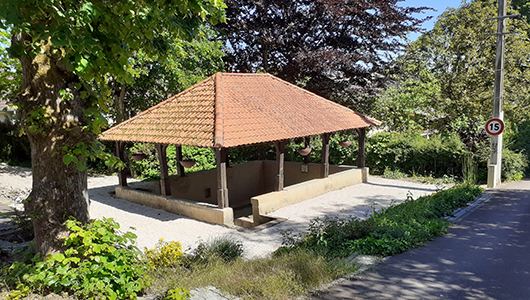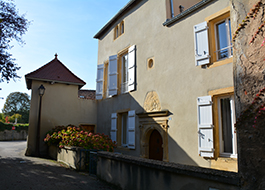Sainte-Ruffine
Durée visite : 20 minutes
Moyen : Pédestre
Lors de fouilles archéologiques réalisées en 1985, des traces de thermes gallo-romains du IIe siècle et d’une villa ont été découverts. Certains historiens pensent qu’il s’agit d’un ancien ibliodorum, c’est-à-dire une étape sur la voie de Trèves à Reims. Sainte-Ruffine est un ancien village de vignerons du Val de Metz, en Pays messin, partagé en plusieurs seigneuries. En 1444, René Ier, duc de Bar et de Lorraine, et son beau-frère Charles VII de France, mirent le siège devant Metz. Ils occupèrent le village. Sainte Rufine est, avec sa sœur Juste, une martyre espagnole. Elles vécurent au IIIe siècle.
During archaeological excavations carried out in 1985, traces of 2nd century Gallo-Roman thermal baths and a villa were discovered. Some historians believe it to be an ancient ibliodorum, that is, a stopover on the way from Trier to Reims. Sainte-Ruffine is a former village of winegrowers in the Val de Metz, in the Metz region, divided into several seigneuries. In 1444, René Ier, Duke of Bar and Lorraine, and his brother-in-law Charles VII of France, laid siege to Metz. They occupied the village. Saint Rufine is, with her sister Juste, a Spanish martyr. They lived in the 3rd century.
Bei archäologischen Ausgrabungen im Jahr 1985 wurden Spuren von galloromanischen Thermalbädern aus dem 2. Jahrhundert und einer Villa entdeckt. Einige Historiker glauben, dass es sich um ein altes Ibliodorum handelt, dh um einen Zwischenstopp auf dem Weg von Trier nach Reims. Sainte-Ruffine ist ein ehemaliges Winzerdorf im Val de Metz in der Region Metz, das in mehrere Seigneuries unterteilt ist. 1444 belagerten René Ier, Herzog von Bar und Lothringen, und sein Schwager Karl VII. Von Frankreich Metz. Sie besetzten das Dorf. Saint Rufine ist mit ihrer Schwester Juste eine spanische Märtyrerin. Sie lebten im 3. Jahrhundert.

D’azur à l’aigle d’or, mi-parti de gueules à la bande d’argent chargée de trois coquilles de sable, au chef de gueules à trois besants d’or, le premier chargé d’une croix pattée.
Armes des seigneurs: l’abbaye de Saint-Arnould de Metz et la famille de Heu. En chef les armes du Val de Metz, dont faisait partie Sainte-Ruffine.
Azure, an eagle of gold, half-party Gules a bend Argent charged with three shells Sable, a chief Gules with three bezants Or, the first charged with a cross pattée.
Weapons of the lords: the Abbey of Saint-Arnould de Metz and the de Heu family. In chief the arms of the Val de Metz, of which Sainte-Ruffine was part.
Azure, ein Adler Gules, eine halbe Partei Argent, mit drei Muscheln aufgeladen Sable, ein Häuptling Gules mit drei Bezants Oder der erste, der mit einem Kreuzmuster beladen ist.
Waffen der Herren: die Abtei Saint-Arnould de Metz und die Familie de Heu. Im Chef die Arme des Val de Metz, zu denen Sainte-Ruffine gehörte.

Les habitants de Sainte-Ruffine s’appellent les Saint-Ruffinois et les Saint-Ruffinoises.
The inhabitants of Sainte-Ruffine are called Saint-Ruffinois and Saint-Ruffinoises.
Die Einwohner von Sainte-Ruffine heißen Saint-Ruffinois und Saint-Ruffinoises.
Les points de visites
.
Vers 1640, la chapelle Saintes Ruffine et Juste a été érigée sur un ancien socle mérovingien. Des pierres de l’ancienne église auraient été utilisées. La voûte est de style gothique. Une statue de la Vierge est présente. Ce serait une copie d’une sculpture du XVe siècle. Très dégradée, l’église fut interdite aux paroissiens dès 1724. D’importants travaux de restauration ont été entrepris depuis cinquante ans. L’association des Amis de la Chapelle s’y consacre.
Around 1640, the Saintes Ruffine et Juste chapel was erected on an old Merovingian plinth. Stones from the old church were reportedly used. The vault is in the Gothic style. A statue of the Virgin is present. It would be a copy of a 15th century sculpture. Very degraded, the church was forbidden to parishioners from 1724. Major restoration work has been undertaken for fifty years. The Friends of the Chapel association is dedicated to this.
Um 1640 wurde die Kapelle Saintes Ruffine et Juste auf einem alten merowingischen Sockel errichtet. Berichten zufolge wurden Steine aus der alten Kirche verwendet. Das Gewölbe ist im gotischen Stil. Eine Statue der Jungfrau ist vorhanden. Es wäre eine Kopie einer Skulptur aus dem 15. Jahrhundert. Sehr degradiert, war die Kirche ab 1724 Gemeindemitgliedern verboten. Seit fünfzig Jahren werden umfangreiche Restaurierungsarbeiten durchgeführt. Der Verein der Freunde der Kapelle widmet sich diesem Thema.
.
.
Il est situé 19 Grand-rue et date du XVIIIe. Il possède un grand escalier à rampe en fer forgé, un salon d’honneur au rez-de-chaussée et un grand salon au premier étage avec leur décor. Il servait de maison de campagne au comte éponyme.
It is located at 19 Grand-rue and dates from the 18th century. It has a large staircase with a wrought iron banister, a main living room on the ground floor and a large living room on the first floor with their decor. It served as a country house for the eponymous count.
Es befindet sich in der Grand Rue 19 und stammt aus dem 18. Jahrhundert. Es hat eine große Treppe mit einem schmiedeeisernen Geländer, ein Hauptwohnzimmer im Erdgeschoss und ein großes Wohnzimmer im ersten Stock mit ihrer Einrichtung. Es diente als Landhaus für den gleichnamigen Grafen.







